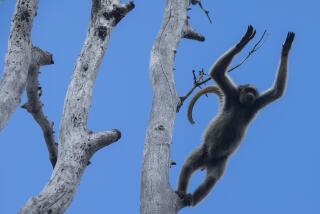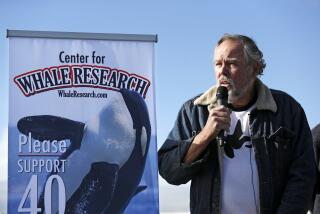Orphan Moose Herd Takes Biologists to School
- Share via
KENAI NATIONAL WILDLIFE REFUGE, Alaska — The moose were impatient for their supper.
As soon as the four ungulates saw biologist Tom Lohuis, they began stomping around in their stables, letting out occasional guttural moans. It was time for their final experimental meal in a five-day research project carried out next to Lohuis’ log-cabin office.
“Hey, hey, hey,” he said as 7-year-old Melody shoved her snout into the dish as soon as he set it down. “They know exactly what’s coming.”
What goes in, of course, must come out. And those droppings are of great interest at the Kenai Moose Research Center, where scientists scrutinize a species found from Alaska’s deepest wilderness to patios and driveways in urban hubs such as Anchorage, the state’s largest city.
At this remote sanctuary, the subjects are orphaned moose raised by humans. They’re used to people.
Researchers say that’s why the state-run center, about 50 miles south of Anchorage, is the global leader in moose investigations. Scientists from around the world get an unprecedented close-up view of the hulking animals in their natural habitat within a four-square-mile section in the Kenai National Wildlife Refuge.
“Almost all research done there has had a direct bearing on management of that species,” said Jim Hall, deputy manager of the 1.97-million-acre refuge, which recently renewed a partnership with the state.
More than 250 research studies have been published since the center was created almost four decades ago. It’s invaluable work with far-reaching benefits for Alaska’s estimated 150,000 moose and other moose populations throughout the Northern Hemisphere, officials said.
“Moose raise a lifetime of research questions,” said Lohuis, a former Laramie, Wyo., bear biologist who took over as director of the center in September 2003. “People have spent their entire careers here.”
So have the half-ton subjects of studies that probe the link between nutrition and reproduction or tests gauging products such as tranquilizers and tracking monitors.
A dozen caribou also are studied at the center, but the 23 resident moose are the undisputed stars.
“These guys are hand-raised and bottle-fed,” Lohuis said. “They’re brought here as calves and live here their entire lives.”
Which explains how you get a moose into a 9-by-12-foot enclosure -- and keep it there for five days -- with relative ease. Try doing that in the wild.
Corralling the animals was necessary for the recent chow fest, part of an ongoing study launched this year to look at the nutritional cost of procreation. The project is comparing Melody and Willow, two pregnant cows close to giving birth, with two non-gestating females, Olivia and Isabella.
During the study period, each moose received daily 18-pound portions of pellet feed, a product developed at the center in the 1980s that contains corn, barley, soybean meal and vitamins. It’s a good supplement to counter stresses such as winter, but moose can’t survive on pellets alone. They need habitat found at the center, such as birch, aspen and some willow trees, fireweed and cranberry bushes.
A straight diet of processed food, however, is ideal in certain situations such as this project, in which every bit of solid and liquid waste is collected, then measured and analyzed. To prepare the moose for such drastic intestinal changes, Lohuis gradually introduced the pellet meal, mixing it with birch and aspen over three weeks until that’s all the animals were eating.
“We’ll look at what goes in as food minus what comes out as waste,” he said. “The difference is what’s required nutritionally.”
Future studies will be more complete, taking place after the fall mating season, then during each trimester in the 231-day moose gestation.
The findings could give scientists a better understanding of certain management areas and whether they can support the number of moose calves they want to see, said Lohuis, whose work is closely intertwined with research on-site and elsewhere in the state by two other staff biologists, John Crouse and Stacy Jenkins.
Predators and road kill can affect moose populations as well. But habitat can be equally crucial when it comes to moose, whose numbers have seen a decline in some parts of the state.
“The beauty of the situation here is that they behave like moose in the pen, they go out and forage, yet they’re still available for research,” Lohuis said. “It’s an ideal setting. You can look at them as many times as you want.”
The center has operated on that premise since it opened in 1969 as a joint venture between the Alaska Department of Fish and Game and the federal government. Until funding began drying up the mid-1980s, the federal government was an active research participant.
In the last few years, however, the Kenai National Wildlife Refuge has rejoined the effort, paying to repair aging fences and build the stalls housing Melody and other moose. Now officials are seeking money for scientific collaborations.
“We look forward to joining the state again in research,” Hall said. “There’s a lot of stuff we can do to benefit wildlife.”
Returning to full capacity would bring the center up to par with its start, when research money was practically unlimited, said Al Franzmann, who ran the facility from 1972 to 1987. Those were the golden years, said Franzmann, a founding member of the North American Moose Foundation, a nonprofit support group based in Mackay, Idaho.
During his tenure at the center, scientists learned important lessons about their subjects. They gauged the effects of overpopulation by penning 17 moose in one of the mile-square pens. Other studies showed them that it takes four times the tranquilizer drugs to down a moose than a much larger elephant.
More to Read
Sign up for Essential California
The most important California stories and recommendations in your inbox every morning.
You may occasionally receive promotional content from the Los Angeles Times.













